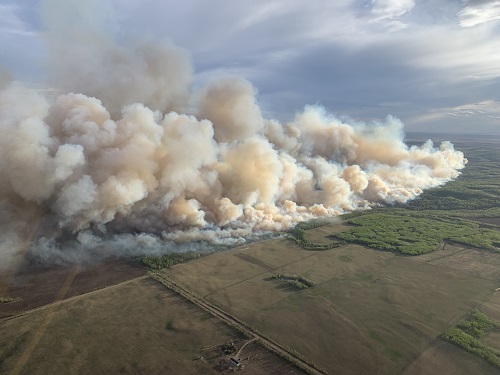Wildfires, air quality is already an issue in Canada
TORONTO – We are not yet in summer but there is already a fire emergency in Canada and the air quality is suffering: in the entire western part of the country, in fact, smoke is creating problems.
In northeastern British Columbia, smoke from the fires triggered a first warning about air quality that is set to spread to other areas, as winds are pushing the smoke towards Alberta, as noted by CTV‘s meteorologist Kelsey McEwen. In fact, since today, central and northern Alberta communities have also been on air quality alert as the smoke is moving north-east, and the same trend is expected to continue tomorrowy.
In the next two days, therefore, very dense smoke will be present in the entire area, according to forecasts.
Even in central Saskatchewan, some communities are dealing with smoke thick enough to trigger warnings for reduced visibility. According to the forecast, tomorrow the smoke will move south, affecting Regina, Yorkton and Brandon, while on Wednesday morning further north, in Saskatoon, a significant presence of smoke is expected.
The Manitoba-Saskatchewan border is also under an air quality alert and smoke is expected in Winnipeg tomorrow. Also tomorrow, smoke from the prairies will likely worsen air quality in northern Ontario as well: according to McEwen, the smoke will affect central Ontario, Sudbury and North Bay while further south the smoke is expected to “linger,” starting tomorrow, along Lake Erie from Windsor to Niagara and along Lake Ontario from Hamilton to Kingston.
There is a possibility of haze in Ottawa and Montreal and tomorrow in the morning the smoke could reach as far as Quebec City (in addition to the smoke, a thunderstorm is also expected over central and southwestern Ontario and the Golden Horseshoe: the storms could bring strong winds, hail and rain).
In the Northwest Territories, smoke will settle over Great Slave Lake as sky conditions improve over Fort Liard and Fort Simpson. However, some parts of western Nunavut are expecting very dense smoke over the next couple of days.
The problem, as we said at the beginning, is: wildfires.
The Canadian Interagency Forest Fire Center reported that, as of May 9, about 90 fires were burning across Canada, with 12 classified as out of control. Of the current fires, 40 are burning in Alberta, 24 in British Columbia and 10 in Manitoba. In Atlantic Canada, 4 fires are burning in New Brunswick, while Ontario has 2 and Quebec 1.
Fire forecasts for the remainder of May and June show elevated risk across Western Canada, except the west coast of British Columbia. There is a very high to extreme risk across much of southern and central Saskatchewan, parts of northern Alberta and interior British Columbia. Most of Ontario and western Quebec are at moderate risk, while eastern Quebec and Atlantic Canada show low risk. In May, most of the Yukon, Northwest Territories and parts of southern Nunavut are at high fire risk, and in June the risk becomes very high and extreme.
But, as the experience of recent years has taught us, it is not always predictable where and when the fires will break out: and this is the biggest issue of the Canadian summer.
In the pic above, one of the fires in Alberta: the photo was published on Saturday on the Twitter page X @AlbertaWildfire



